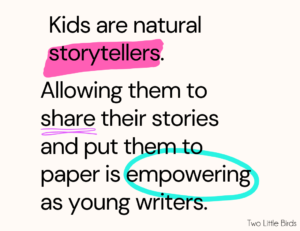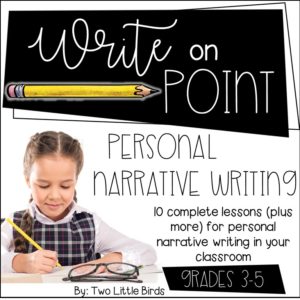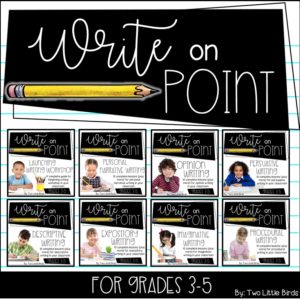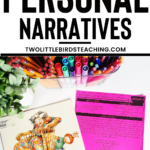Personal narratives is always a fun genre of writing to teach, but it can also be challenging. Students LOVE to tell their own stories, we already know this from their day-to-day storytelling antics. But, focusing on one story to tell, zeroing in on the moments that are worth telling, and captivating their audience in the process are all a part of the narrative writing process that helps students develop as storytellers and writers.

Let's take a look at some strategies to teach narrative writing…
What is personal narrative writing?
Narrative writing tells a story. It can be fictional or personal. Narrative writing follows a sequence of events, has characters that develop in the story, and can have a problem and solution.
Kids are natural storytellers and have so much to share! Allowing them to share their stories and put them to paper is empowering as young writers. They can choose memorable moments, favorite experiences, honored traditions, school memories, and so many other topics that are close to their hearts and fresh in their minds.
Personal narrative writing gives students the opportunity to work on creating strong introductions, learn to use dialogue, craft a story with a clear beginning, middle, and end; narrow down their details, and so much more!

Coming up with ideas for personal narratives
“S is for Story” by Esther Hershenhorn is a great book to use to help students generate ideas for their writing. Discuss the parts of a story (characters, setting, etc) and discuss what narrative writing is.

“Fireflies” by Julie Binkckloe is a great book to read and discuss how the author has “zoomed in” to a small moment in a long summer. You can discuss with students all of the fun they had in the summer and how many “big moments” fill their summers. The narrator probably had a busy summer too, but the story zooms in to one small moment: catching fireflies, to capture the audience’s attention.

“Wilfred Gordon McDonald Partridge” by Mem Fox is always one of my favorite books to read while teaching personal narratives. It is the perfect book to discuss how we can tell stories through memories. I love to have the discussion: what is a memory to YOU?

“Enemy Pie” by Derek Munson allows students to see a problem in a story. How is the problem solved? What is the small moment for the narrator in the story? You can discuss the story elements: the setting, characters, problem, solution, and how the story has a clear beginning, middle, and end. And also point out how the author limits the number of characters and the setting in order to zoom in on the small moment.

Finding your voice while writing
Student's voices in their writing become their own writing style. They can express their thoughts and feelings, use vivid language and details, and let their personalities show. The best part of personal narrative writing is that the students are the expert of their own narratives.
Each of the crayons in “The Day the Crayons Quit” by Drew DeWalt truly has its own voice and is a perfect mentor text when you are teaching voice. They have a personality and we feel like we get to know them in the story…we have compassion and we even begin to consider if we use that color enough! When students put their feelings into their writing, the reader will get to know them and the writing magic begins!

Writing from your own perspective
When writing a personal narrative, students are the expert of the story. They have a different perspective on the memory, even from other people that may have been there! Taking on their own perspective means including the details that only they know!
For example, you may be telling a story about a beach vacation. You do not need to describe WHAT a beach is…but tell us more about your feelings on the beach, your observations, your experience.
“A Moment in Time” by Jennifer Butenas tells a story that is different for each of the four characters. It was a small moment in time, but each person had a different perspective.

Personal narrative writing allows students to share their own points of view, attitudes, feelings, or thoughts about a situation which allows them to create a story with voice, perspective, and personality.
Giving students strategies to use as writers will help make personal narrative writing meaningful and fun! I hope you have some new strategies to use while you are teaching narratives!
You might also like to read more about teaching persuasive writing in THIS POST.
Shop all of the resources in this post here:
Happy Writing!




